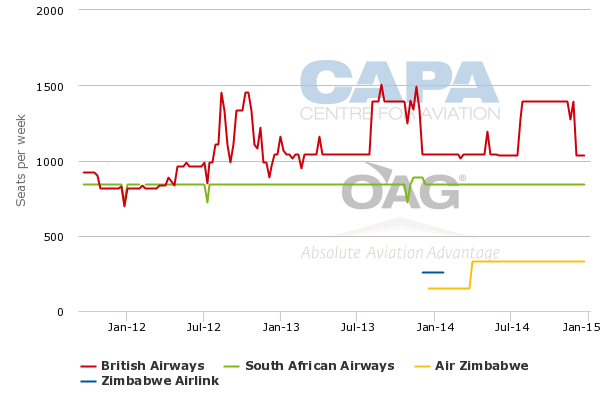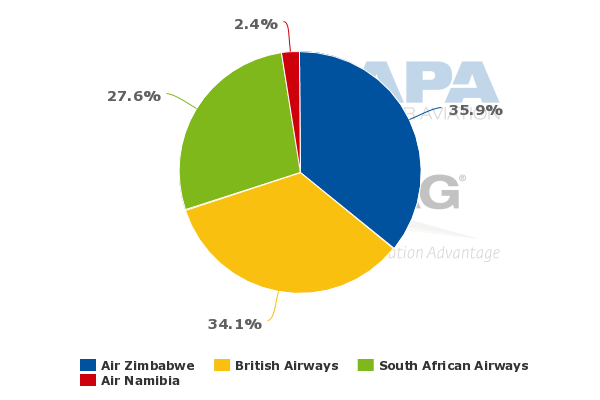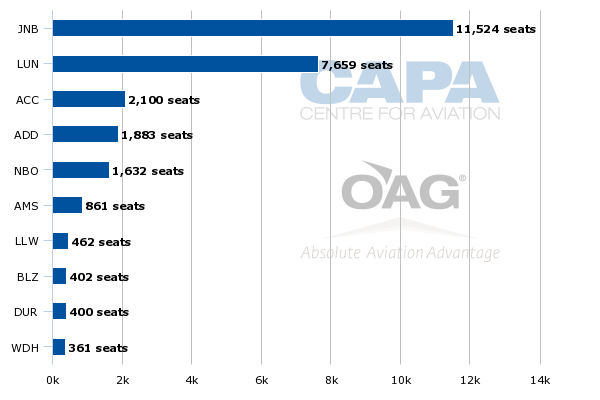flyafrica.com and fastjet give Zimbabwe its first taste of LCCs with local start-up
The Zimbabwe market is poised for growth as new African low-cost carrier group flyafrica.com prepares to launch services by the end of Jul-2014 using a Zimbabwean air operator's certificate. flyafrica plans initially to link the Zimbabwean resort town of Victoria Falls with Johannesburg, a market burdened by high fares and controlled by two South African full-service airlines.
flyafrica will become only the seventh African LCC and is aiming to become the second pan-African LCC group after fastjet. flyafrica is aiming gradually to establish affiliates throughout Africa, following the model used by fastjet since late 2012.
fastjet is meanwhile planning to launch services on 5-Aug to the Zimbabwean capital Harare with a new route from its base in Dar es Salaam, Tanzania. fastjet, which is now in the process of launching an affiliate in neighbouring Zambia, is also looking at potentially establishing a Zimbabwean affiliate with the goal of entering the lucrative Harare-Johannesburg route.
Zimbabwe is a relatively small market, with about 33,000 weekly international seats. The market is currently only served by 13 foreign carriers, led by South African Airways, according to OAG data.
Government-owned flag carrier Air Zimbabwe currently operates only two international routes although it has been trying for some time to resume more international services.
Zimbabwe international capacity (seats) by carrier: 30-Jun-2014 to 6-Jul-2014
The Zimbabwean market, however, has tremendous potential. Zimbabwe's economy has stabilised in recent years, aided by the adoption of the US dollar as its official currency (which ended a period of hyperinflation) and boosted by its natural resources sector.
Like most other countries in the region, Zimbabwe is underserved with growth prospects curtailed by high average fares.
flyafrica selects Zimbabwe as initial base
Zimbabwe authorities are keen to attract LCCs to stimulate demand and help boost the country's economy, including its tourism sector. Victoria Falls, which is in the process of upgrading its airport with a runway extension and expanded terminal, hosted the recent Routes Africa conference as part of an initiative by Zimbabwean authorities to attract more air services.
flyafrica has selected Zimbabwe as its first base, a testament to the market's potential and the government's relatively liberal policy on new entrants. flyafrica has been quietly working over the past two years, from an office in Johannesburg, on establishing a pan-African LCC airline group. flyafrica Zimbabwe was established as a joint venture by the flyafrica investment firm and a Zimbabwean infrastructure company.
Setting up initially in Zimbabwe is a sensible move for flyafrica as accessing international route rights as a South African start-up would be nearly impossible. flyafrica Zimbabwe is evaluating several potential routes in the South Africa-Zimbabwe market, which will likely account for a majority of the airline's capacity as it expands its 737-500 fleet. flyafrica Zimbabwe is also planning to operate domestic services, which will likely be added in a couple of months as a second 737-500 enters service.
The group also has been working on establishing affiliates in other African countries. Malawi could potentially become its second base as flyafrica group CEO Adrian Hamilton-Manns has said the group has already established a company in Malawi.
flyafrica opts for 737-500 in dual-class configuration
The group has reportedly acquired five 737-500s from Czech Airlines, with the remaining three likely to be delivered in 2015. The first two aircraft are now parked at Johannesburg airport pending Zimbabwean registration and are 22 years old, according to the CAPA Fleet Database.
flyafrica has opted to configure its 737-500s with two classes, giving it a hybrid business model. Economy passengers will be able to purchase drinks and snacks and rent iPads pre-loaded with in-flight entertainment. flyafrica will also charge economy passengers for checked bags but not for seat assignments as passengers are checked-in as soon as the booking is completed.
Business class passengers will be offered drinks, meals and tablets free of charge. flyafrica's 737-500s will feature a fixed business cabin, with recliner style seats in two by two configuration.
flyafrica will be the first African LCC with a business class cabin as the six existing LCCs - Comair subsidiary Kulula, South African Airways (SAA) subsidiary Mango, Kenya Airways subsidiary Jambojet, fastjet, Air Arabia Egypt and Air Arabia Maroc - operate 737 or A320 family aircraft in all-economy configuration. (The two Air Arabia affiliates only currently serve the Middle East and Europe, giving the intra-Africa market only four LCCs with flyafrica Zimbabwe poised to become the fifth.)
By offering a business class cabin flyafrica is aiming to attract business and upmarket leisure passengers. Having a business class and using the smallest version of the 737 will give flyafrica an unusually small economy cabin for an LCC and result in a relatively high per seat cost. But higher load factors will be easier to achieve.
Load factors are generally low in Africa and most regional routes in Africa are thin - even with the low fare stimulation. fastjet operates an all-A319 fleet, which is also a small aircraft for an LCC with relatively high seat costs, although it is not considering offering a business class and pursues a relatively pure model.
flyafrica will initially serve Victoria Falls-Johannesburg route
flyafrica Zimbabwe began ticket sales in mid-Jun-2014 for three weekly flights between Victoria Falls and Johannesburg starting 16-Jul-2014. Its website states that flights will now begin on 23-Jul-2014, representing a one week delay.
Start-up carriers in Africa almost always encounter delays in launching international routes. Securing approvals from South Africa can be particularly tedious, usually with a strong undercurrent of protectionism. fastjet Tanzania for example faced repeated delays before it finally was able to launch services in Oct-2013 on Dar es Salaam-Johannesburg, its first international route. Further delays to the launch are possible even though flyafrica has everything lined up from the Zimbabwean end including an AOC and is designated to exercise authorised traffic rights for South Africa.
See related report: Low-cost airlines start to penetrate African international market, led by fastjet
Dar es Salaam-Johannesburg and Victoria Falls-Johannesburg are similar routes in that they are dominated by South African carriers and have typically been characterised by high fares. There are huge opportunities to stimulate demand in the Victoria Falls-Johannesburg market, but flyafrica's entry will likely spur a competitive response.
The Victoria Falls-Johannesburg market is currently served with one daily flight from SAA and one daily flight from British Airways' South African franchise Comair. Air Zimbabwe also currently operates three weekly flights between Victoria Falls and Johannesburg, having resumed the route in Dec-2013.
Victoria Falls to Johannesburg capacity by carrier (one-way seats per week): 19-Sep-2011 to 28-Dec-2014
Return fares on the slightly less than two-hour route now start at about USD430 including taxes but generally exceed USD600 although the Victoria Falls market predominantly consists of leisure traffic. flyafrica is offering lead in one-way fares that start at USD10 or USD60, including all taxes. Even flyafrica's business class fare, which starts at USD315 including taxes, is competitive with the average economy class fare from Comair and SAA. (flyafrica has taken the decision not to have a fuel surcharge.)
flyafrica should be able to stimulate demand by targeting price conscious leisure travellers while potentially wooing over business passengers who are now flying full-service economy. It will be the first carrier with a low fare option for visitors of Victoria Falls, the largest waterfall in the world, since South African LCC 1time ceased operations in 2012. 1time served Livingstone in Zambia, a tourist town near the falls and only about 10km from Victoria Falls Airport. (The falls themselves straddle the Zimbabwe-Zambia border).
Victoria Falls' catchment area includes four countries
By offering a low fare option, flyafrica should be able to attract passengers heading from South Africa to the Zambian side of the falls as well as parts of northeast Botswana and northeast Namibia. Kasane in Botswana is slightly less than 100km from Victoria Falls and is the gateway to the Chobe National Park, a popular safari spot. Kasane is only now served from Johannesburg by SAA regional partners and Air Botswana. Air Botswana also has domestic services at Kasane.
Livingstone is only served by three foreign carriers and one domestic carrier. SAA and Comair both operate one daily flight to Livingstone from Johannesburg while SAA also offers five weekly flights from Kruger using its regional partners. Kenya Airways provides the only non-South African link, with three weekly flights on a Nairobi-Livingstone-Harare-Livingstone triangle routing. Zambian carrier Proflight only operates domestic services at Livingstone.
In addition to Johannesburg, Victoria Falls is now only linked to two other international destinations, Windhoek in Namibia and Maun in Botswana. Air Namibia is the only foreign carrier besides SAA and Comair with scheduled service at Victoria Falls, operating four weekly ERJ-135 regional jet flights to Windhoek with two frequencies stopping in Maun.
In addition to Johannesburg, Air Zimbabwe currently offers two domestic routes from Victoria Falls-Harare (served five times per week) and Bulawayo (served two times per week).
Air Zimbabwe currently accounts for about 36% of system-wide seat capacity at Victoria Falls compared to about 34% for Comair (operating under the BA code), 28% for SAA and 2% for Air Namibia.
Victoria Falls Airport capacity share (% of seats) by carrier: 30-Jun-2014 to 6-Jul-2014
flyafrica Zimbabwe aims to serve several routes by end of 2014
flyafrica Zimbabwe is also planning to serve the domestic market with two routes expected to be launched within the next few months. Victoria Falls to Harare and Harare to Bulawayo are the most likely routes as Victoria Falls-Bulawayo is a much smaller market.
Harare-Bulawayo is the largest domestic route in Zimbabwe as it connects the main two cities, resulting in significant business demand, while Victoria Falls is mainly a leisure market. Air Zimbabwe currently operates 12 weekly flights between Harare and Bulawayo, according to OAG data.
flyafrica Zimbabwe also plans to launch additional international routes by the end of 2014. It is currently looking at Durban in South Africa and Lusaka in Zambia, both of which would more likely be served from Harare. The carrier will also consider adding capacity on Victoria Falls-Johannesburg as it has been allocated five weekly frequencies on the route. Harare-Johannesburg would also be a logical addition for flyafrica.
Johannesburg and Lusaka are the two largest international markets from Harare. There are currently about 11,500 weekly return seats between Harare and Johannesburg while there are about 7,700 weekly return seats between Harare and Lusaka, according to CAPA and OAG data.
No other international route currently has more than 2,100 weekly international seats. But flyafrica believes with low fares there is sufficient demand to launch several international routes which have limited or no service. For example, Lagos is not currently served from Harare but is a potential flyafrica Zimbabwe route.
Harare top 10 international routes ranked by seat capacity: 30-Jun-2014 to 6-Jul-2014
fastjet to enter Zimbabwean market with service from Tanzania
fastjet also sees significant potential in the Harare market. fastjet Tanzania plans to launch twice weekly flights to Harare from Dar es Salaam on 5-Aug-2014. Therefore it will beat flyafrica in becoming the first LCC in the Harare market, although flyafrica should quickly overtake fastjet as a larger LCC in Harare as it has a local AOC.
The Harare-Dar es Salaam market is not currently served by any airline. But fastjet CEO Ed Winter says there are about 200 bus passengers per day on the route - even though the bus costs USD120 and takes three days. Business passengers heading between Harare and Dar es Salaam currently fly circuitous and very expensive routings via Johannesburg and Nairobi.
fastjet is keen to add capacity on the Harare-Dar es Salaam route as well as add more routes from Zimbabwe. While the group has said it is looking at Victoria Falls it sees more opportunities in Harare. Dar es Salaam-Victoria Falls is not likely to be a viable route at this point.
Harare-Johannesburg is likely to become a much more competitive market
fastjet is particularly interested in the Harare-Johannesburg market as most passengers travelling between the two cities now take the bus due the absence of a low fare option. fastjet estimates there are between 50 and 70 daily buses making the long road journey from Harare to Johannesburg. SAA operates between four and five daily flights on the Harare-Johannesburg route while BA and Air Zimbabwe each operate one daily frequency, according to OAG data.
While Harare-Johannesburg is a large business market there is also a large Zimbabwean community in South Africa. There is huge potential for LCCs to tap into and stimulate the migrant worker and visiting family and friends sector of the Zimbabwe-South Africa market - a market which now generally goes by bus. As almost of all of this market is from Harare rather than Victoria Falls, Harare-Johannesburg is potentially a much bigger LCC route than Victoria Falls-Johannesburg.
Harare-Durban, which is now served by SAA with four weekly flights operated by regional partners, also has LCC potential as there is a large Zimbabwean community in Durban.
fastjet sees opportunities in underserved Zimbabwe
fastjet will need a Zimbabwean AOC to enter the Zimbabwe-South Africa market as there are no additional traffic rights available to South African carriers. As CAPA outlined earlier this week, fastjet is planning to launch a South African affiliate in 2015 but does not expect its South African carrier will be able to operate international routes and instead plans to cover the South African international market by launching services from its other bases throughout Africa.
See related report: African LCC fastjet accelerates expansion with three new bases and 10 more aircraft by end-2015
A Zimbabwean base is currently not in fastjet's four-year business plan as the group is now focusing on neighbouring Zambia as well as South Africa and Kenya. But Zimbabwe is being reviewed and could potentially leapfrog the other potential bases depending on how those projects proceed from a regulatory and partnership perspective. "We see a lot of opportunity in Zimbabwe. It looks like a very attractive country in terms of air travel," Mr Winter told CAPA, pointing to the increased stability and improved economy.
Zimbabwe could eventually evolve into a showdown between fastjet and flyafrica. Both have the potential of overtaking Air Zimbabwe as Zimbabwe's largest carrier, assuming the government remains receptive to the concept of opening its market to LCCs and does not overly protect its long ailing flag carrier.
Air Zimbabwe, which re-launched in Nov-2012 after a recapitalisation from the government, is again looking at fleet renewal, regional network expansion and resuming London service. But Air Zimbabwe is currently saddled with an ageing fleet of two 737-200s and one 767-200 serving only three domestic points and one international destination, Johannesburg. Earlier plans to launch several regional international destinations and London in late 2013 have never materialised.
See related reports: Air Zimbabwe prepares to rebuild its regional network and relaunch London services
A vibrant local LCC sector could be a more viable long-term solution for the domestic and regional international markets. The Zimbabwean market, however, may not ultimately be large enough to support two local LCCs - although that is something a potential growth market can work out for itself.
Zimbabwe could become the foundation for a fastjet-flyafrica battle
fastjet and flyafrica will inevitably face off in several markets as flyafrica also aims to establish multiple bases over the next year or two. There should be room for both players as the intra-Africa market overall is ripe for stimulation.
There are currently only about 2,500 international weekly LCC seats within Africa. This is the equivalent of less than 1% of the intra-Africa international market - so it is no surprise this market has some of the highest average fares in the world.
Currently only fastjet (with two and soon three international routes) and Mango (with one international route) are the only LCCs operating international services within Africa as Jambojet and Kulula are purely domestic while Air Arabia Egypt and Maroc only serve Europe and the Middle East.
Breaking into the regional international market will not be easy. In restrictive bilateral markets, Africa's heavyweights will be sure to put up a fight and are not likely to simply hand off routes such as Johannesburg-Victoria Falls or Johannesburg-Harare to their budget subsidiaries.
flyafrica will face an uphill battle against SAA and Comair as it launches services on Johannesburg-Victoria Falls. It will be the first of many challenges flyafrica will need to overcome if it is to meet its goal of establishing a pan-African LCC network - as a more experienced but still struggling fastjet can attest.



